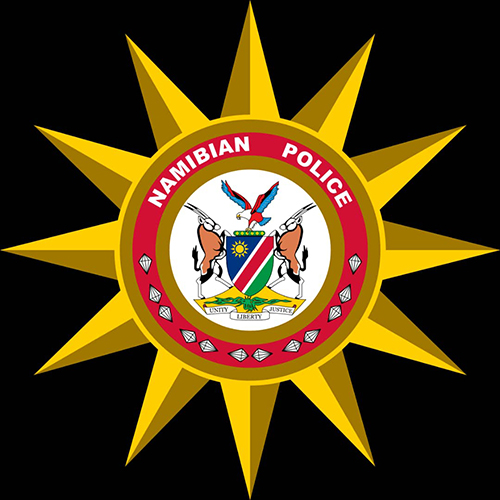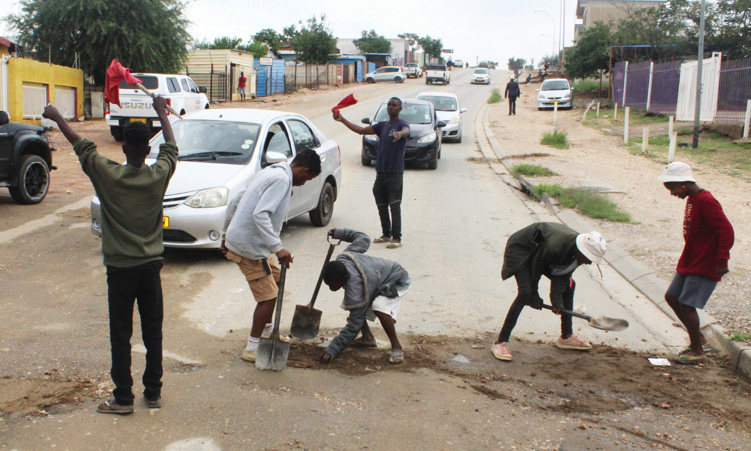THE water level just kept rising and rising.
After Hannelise Kendzia had sealed what she thought were all the openings to their Windhoek West house, the water started pouring through the keyhole. A kilometre further west in Acacia, Vicky Naanda climbed up the burglar bars across her kitchen entrance to escape the rising tide in her home when “suddenly a sofa ran past my house”.Such was the force of the Arrebbusch river that it flooded at least 35 houses in the Acacia housing complex on the western side of Windhoek on Friday night.The river swept along everything in its path – one car ended up in Khomasdal several kilometres away.Only the houses remained standing and they were left half-full of muddy water.People formed human chains to rescue trapped families and clutched onto ropes as they fled their homes upstream, only to be halted by the electric fence of the complex.”We have been praying for rain … today God has spoken and we just have to stand and listen,” said Sophia Shaningwa, Regional Councillor for Windhoek West.Grethe Keding, a resident of Avis, east of the city, likened what she saw on Friday night to the floods of 1934.It is believed that Friday’s showers brought the highest rainfall figures in the capital in 20 years.Simon Dirkse of the Chief Hosea Kutako International Airport Meteorological Office said 108 mm of rain fell at the south eastern suburb of Kleine Kuppe between 08h00 and 24h00 on Friday.In Suiderhof, the Weather Bureau recorded 80 mm, 52 mm near the centre of the city, while both Dorado Park and Katutura received 36 mm.Friday’s rains did not only hit Windhoek.Khorixas received 100 mm that night.One man and two women in a bakkie were swept away after attempting to cross the Aba-Huab river.The vehicle has since been found, but the bodies are still missing, said Police spokesperson Warrant Officer Christopher Munyika yesterday.Karibib had to be closed to traffic because “a river formed on the main road”, according to a Police officer there.Windhoek’s rivers roared through the city, taking with them chunks of tar, bridges, water-level markers, at least 10 cars, sofas and other household items.The current gave dogs no chance of swimming to safety.Dogs, cats and other pets drowned; some vanished altogether.”I went to bed on Friday and thought I was in Swakopmund.It sounded like the ocean was roaring just outside my window,” said Gert Keding, who lives on Avis Road next to the Klein Windhoek River.The Klein Windhoek River caused pandemonium along its course, spurred on by the overflowing Avis dam.The dam’s level rose from 47 per cent to 104 per cent in two hours, said Rudi Vaessler, Disaster Management Co-ordinator of the City of Windhoek .With the soil already saturated from rain, “by Friday, there was a greater run-off than there was water able to penetrate into the ground,” said Dirkse.On Saturday and yesterday residents were adding up their losses and cleaning up.Windhoek Municipality Public Relations Officer, Scheifert Shigwedha, said all major services were working hard over the weekend to get the city back to normal as soon as possible.The Weather Bureau’s Dirkse said the capital was unlikely experience a similar disaster soon.”The high pressure system is moving north-east, so now it’s the Caprivi area which will receive these heavy thunderstorms”.A kilometre further west in Acacia, Vicky Naanda climbed up the burglar bars across her kitchen entrance to escape the rising tide in her home when “suddenly a sofa ran past my house”. Such was the force of the Arrebbusch river that it flooded at least 35 houses in the Acacia housing complex on the western side of Windhoek on Friday night. The river swept along everything in its path – one car ended up in Khomasdal several kilometres away. Only the houses remained standing and they were left half-full of muddy water. People formed human chains to rescue trapped families and clutched onto ropes as they fled their homes upstream, only to be halted by the electric fence of the complex. “We have been praying for rain … today God has spoken and we just have to stand and listen,” said Sophia Shaningwa, Regional Councillor for Windhoek West. Grethe Keding, a resident of Avis, east of the city, likened what she saw on Friday night to the floods of 1934. It is believed that Friday’s showers brought the highest rainfall figures in the capital in 20 years. Simon Dirkse of the Chief Hosea Kutako International Airport Meteorological Office said 108 mm of rain fell at the south eastern suburb of Kleine Kuppe between 08h00 and 24h00 on Friday. In Suiderhof, the Weather Bureau recorded 80 mm, 52 mm near the centre of the city, while both Dorado Park and Katutura received 36 mm. Friday’s rains did not only hit Windhoek. Khorixas received 100 mm that night. One man and two women in a bakkie were swept away after attempting to cross the Aba-Huab river. The vehicle has since been found, but the bodies are still missing, said Police spokesperson Warrant Officer Christopher Munyika yesterday. Karibib had to be closed to traffic because “a river formed on the main road”, according to a Police officer there. Windhoek’s rivers roared through the city, taking with them chunks of tar, bridges, water-level markers, at least 10 cars, sofas and other household items. The current gave dogs no chance of swimming to safety. Dogs, cats and other pets drowned; some vanished altogether. “I went to bed on Friday and thought I was in Swakopmund. It sounded like the ocean was roaring just outside my window,” said Gert Keding, who lives on Avis Road next to the Klein Windhoek River. The Klein Windhoek River caused pandemonium along its course, spurred on by the overflowing Avis dam. The dam’s level rose from 47 per cent to 104 per cent in two hours, said Rudi Vaessler, Disaster Management Co-ordinator of the City of Windhoek . With the soil already saturated from rain, “by Friday, there was a greater run-off than there was water able to penetrate into the ground,” said Dirkse. On Saturday and yesterday residents were adding up their losses and cleaning up. Windhoek Municipality Public Relations Officer, Scheifert Shigwedha, said all major services were working hard over the weekend to get the city back to normal as soon as possible. The Weather Bureau’s Dirkse said the capital was unlikely experience a similar disaster soon. “The high pressure system is moving north-east, so now it’s the Caprivi area which will receive these heavy thunderstorms”.
Stay informed with The Namibian – your source for credible journalism. Get in-depth reporting and opinions for
only N$85 a month. Invest in journalism, invest in democracy –
Subscribe Now!










